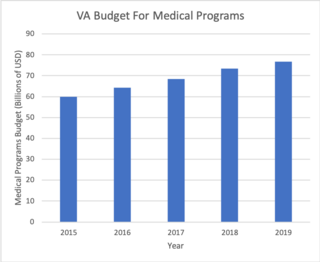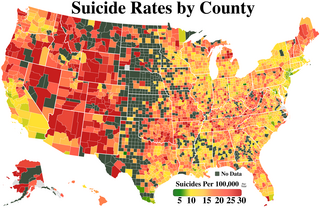
A veteran is a person who has significant experience and expertise in an occupation or field.

The Veterans Health Administration (VHA) is the component of the United States Department of Veterans Affairs (VA) led by the Under Secretary of Veterans Affairs for Health that implements the healthcare program of the VA through a nationalized healthcare service in the United States, providing healthcare and healthcare-adjacent services to veterans through the administration and operation of 146 VA Medical Centers (VAMC) with integrated outpatient clinics, 772 Community Based Outpatient Clinics (CBOC), and 134 VA Community Living Centers Programs. It is the largest division in the department, and second largest in the entire federal government, employing over 350,000 employees. All VA hospitals, clinics and medical centers are owned by and operated by the Department of Veterans Affairs, and all of the staff employed in VA hospitals are federal employees. Because of this, veterans that qualify for VHA healthcare do not pay premiums or deductibles for their healthcare but may have to make copayments depending on the medical procedure. VHA is not a part of the US Department of Defense Military Health System.
A crisis hotline is a phone number people can call to get immediate emergency telephone counseling, usually by trained volunteers. The first such service was founded in England in 1951 and such hotlines have existed in most major cities of the English speaking world at least since the mid-1970s. Initially set up to help those contemplating suicide, many have expanded their mandate to deal more generally with emotional crises. Similar hotlines operate to help people in other circumstances, including rape, bullying, self-harm, runaway children, human trafficking, and people who identify as LGBT or intersex. Despite crisis hotlines being common, their effectiveness in reducing suicides is not clear.
Ten-digit dialing is a telephone dialing procedure in the countries and territories that are members of the North American Numbering Plan (NANP). It is the practice of including the area code of a telephone number when dialing to initiate a telephone call. When necessary, the ten-digit number may be prefixed with the trunk code 1, which is referred to as 1+10-digit dialing or national format.

Suicide prevention is a collection of efforts to reduce the risk of suicide. Suicide is often preventable, and the efforts to prevent it may occur at the individual, relationship, community, and society level. Suicide is a serious public health problem that can have long-lasting effects on individuals, families, and communities. Preventing suicide requires strategies at all levels of society. This includes prevention and protective strategies for individuals, families, and communities. Suicide can be prevented by learning the warning signs, promoting prevention and resilience, and committing to social change.
Suicide intervention is a direct effort to prevent a person or persons from attempting to take their own life or lives intentionally.

Iraq and Afghanistan Veterans of America (IAVA), is a nonprofit 501(c)(3) veterans organization founded by Paul Rieckhoff, an American writer, social entrepreneur, advocate, activist and veteran of the United States Army and the Iraq War. He served as an Army First Lieutenant and infantry rifle platoon leader in Iraq from 2003 through 2004. Rieckhoff was released from the Army National Guard in 2007.
A suicide crisis, suicidal crisis or potential suicide is a situation in which a person is attempting to kill themselves or is seriously contemplating or planning to do so. It is considered by public safety authorities, medical practice, and emergency services to be a medical emergency, requiring immediate suicide intervention and emergency medical treatment. Suicidal presentations occur when an individual faces an emotional, physical, or social problem they feel they cannot overcome and considers suicide to be a solution. Clinicians usually attempt to re-frame suicidal crises, point out that suicide is not a solution and help the individual identify and solve or tolerate the problems.
CrisisLink is a non-profit 24-hour mental health and suicide-prevention hot line based in Arlington, Virginia. Founded in 1969, CrisisLink fields more than 20,000 calls annually. The majority of calls to CrisisLink are fielded by trained volunteers. CrisisLink is part of the National Suicide Prevention Lifeline.
Military psychiatry covers special aspects of psychiatry and mental disorders within the military context. The aim of military psychiatry is to keep as many serving personnel as possible fit for duty and to treat those disabled by psychiatric conditions. Military psychiatry encompasses counseling individuals and families on a variety of life issues, often from the standpoint of life strategy counseling, as well as counseling for mental health issues, substance abuse prevention and substance abuse treatment; and where called for, medical treatment for biologically based mental illness, among other elements.
988 is a telephone number used in some North American (NANP) countries for a suicide prevention helpline. In the United States, it is known as the 988 Suicide & Crisis Lifeline. In Canada, it is known as the 9-8-8 Suicide Crisis Helpline.

Suicide is a major national public health issue in the United States. The country has one of the highest suicide rates among wealthy nations. In 2020, there were 45,799 recorded suicides, up from 42,773 in 2014, according to the CDC's National Center for Health Statistics (NCHS). On average, adjusted for age, the annual U.S. suicide rate increased 30% between 2000 and 2020, from 10.4 to 13.5 suicides per 100,000 people. In 2018, 14.2 people per 100,000 died by suicide, the highest rate recorded in more than 30 years. Due to the stigma surrounding suicide, it is suspected that suicide is generally underreported. In April 2016, the CDC released data showing that the suicide rate in the United States had hit a 30-year high, and later in June 2018, released further data showing that the rate has continued to increase and has increased in every U.S. state except Nevada since 1999. From 2000 to 2020, more than 800,000 people died by suicide in the United States, with males representing 78.7% of all suicides that happened between 2000 and 2020. In 2022, a record high 49,500 people died by suicide, while the suicide rate in 2022 reached its highest level since 1941 at 14.3 per 100,000 persons. Surging death rates from suicide, drug overdoses and alcoholism, what researchers refer to as "deaths of despair", are largely responsible for a consecutive three year decline of life expectancy in the U.S. This constitutes the first three-year drop in life expectancy in the U.S. since the years 1915–1918.
Switchboard of Miami, Inc., commonly referred to as Switchboard, was a private, nonprofit and registered 501(c)(3) organization located in Miami, Florida, United States that provided Miami-Dade County with comprehensive telephone counseling and referral services to thousands of social service programs beginning in 1968. The organization also offered counseling services and prevention programs, such as initiatives aimed at assisting high-risk youth and their families through partnerships with local schools. Since 1968, these services have been offered to the community at no charge. Callers can seek advice confidentially, as no information is needed by the company in order to receive the services. Switchboard shut down in 2016 following a "major financial emergency".
The National Action Alliance for Suicide Prevention is an American suicide prevention organization coordinating national efforts to advance the National Strategy for Suicide Prevention (NSSP). It is a public/private partnership that, according to them, "catalyzes planning, implementation, and accountability for updating and advancing the NSSP. The Action Alliance works on the 2001 National Strategy for Suicide Prevention and is an outgrowth of the Suicide Prevention Resource Center. The Action Alliance initially focused on three high-risk populations: LGBT youth, American Indians/Alaska Natives, and military/veterans. Part of the group's campaign will be to educate on the warning signs of suicide, promoting the National Suicide Prevention Lifeline, as well as community crisis clinics across the U.S.

United States military veteran suicide is an ongoing phenomenon regarding the high rate of suicide among U.S. military veterans in comparison to the general civilian public. A focus on preventing veteran suicide began in 1958 with the opening of the first suicide prevention center in the United States. During the mid-1990s, a paradigm shift in addressing veteran suicide occurred with the development of a national strategy which included several Congressional Resolutions. More advancements were made in 2007, when the Joshua Omvig Veterans Suicide Prevention Act created a comprehensive program including outreach at each Veterans Affairs Office (VA) and the implementation of a 24-hour crisis hotline. PTSD, depression, and combat-related guilt in veterans are often related to suicide as it can be difficult for veterans to transition to civilian life.

Crisis Hotline: Veterans Press 1 is a 2013 documentary film about the Veterans Crisis Line, directed by Ellen Goosenberg Kent and produced by Dana Perry. The film was edited by Geof Bartz, A.C.E and co-edited by Gladys Mae Murphy. The cinematography was done by Tony Hardmon. It won the Academy Award for Best Documentary at the 87th Academy Awards.
Crisis Text Line is a global nonprofit organization providing free and confidential text-based mental health support and crisis intervention by texting HOME to 741741. The organization launched in 2013, and its services are available 24 hours a day throughout the United States, Canada, UK, and Ireland. As of March 2024, the organization reported that it had supported over 9 million support conversations.
Project Semicolon – stylized as Project ; – is an American nonprofit organization known for its advocacy of mental health wellness and its focus as an anti-suicide initiative. Founded in 2013, the movement's aim is "presenting hope and love to those who are struggling with depression, suicide, addiction and self-injury". They are known for encouraging people to tattoo the punctuation mark semicolon (;) as a form of solidarity between people dealing with mental illness or the death of someone from suicide.

The health access and health vulnerabilities experienced by the lesbian, gay, bisexual, transgender, queer or questioning, intersex, asexual (LGBTQIA) community in South Korea are influenced by the state's continuous failure to pass anti-discrimination laws that prohibit discrimination based on sexual orientation and gender identity. The construction and reinforcement of the South Korean national subject, "kungmin," and the basis of Confucianism and Christian churches perpetuates heteronormativity, homophobia, discrimination, and harassment towards the LGBTQI community. The minority stress model can be used to explain the consequences of daily social stressors, like prejudice and discrimination, that sexual minorities face that result in a hostile social environment. Exposure to a hostile environment can lead to health disparities within the LGBTQI community, like higher rates of depression, suicide, suicide ideation, and health risk behavior. Korean public opinion and acceptance of the LGBTQI community have improved over the past two decades, but change has been slow, considering the increased opposition from Christian activist groups. In South Korea, obstacles to LGBTQI healthcare are characterized by discrimination, a lack of medical professionals and medical facilities trained to care for LGBTQI individuals, a lack of legal protection and regulation from governmental entities, and the lack of medical care coverage to provide for the health care needs of LGBTQI individuals. The presence of Korean LGBTQI organizations is a response to the lack of access to healthcare and human rights protection in South Korea. It is also important to note that research that focuses on Korean LGBTQI health access and vulnerabilities is limited in quantity and quality as pushback from the public and government continues.









